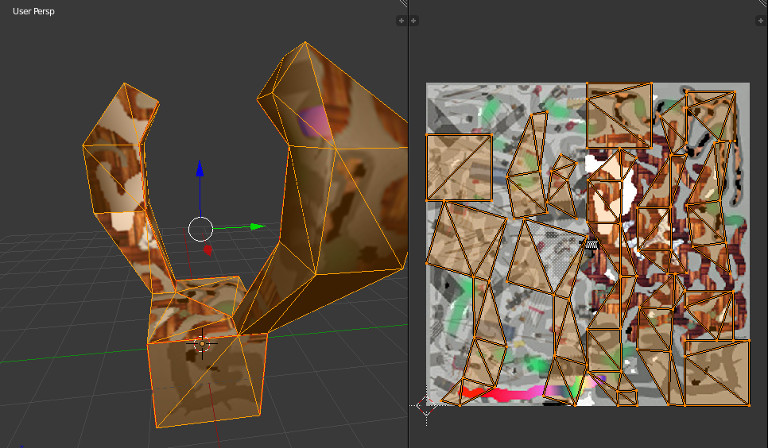Models¶
3D models can be made and edited using a wide variety of software and saved in nearly as large a variety of formats. In pi3d, at the moment, there are just two file types that can be parsed: wavefront obj and Panda3D egg. Of these two the obj is simpler and faster to load.

Blender screen-capture
If you have blender [1] installed on your PC then you can open the file model01.blend [2] or you can view it by running the pi3d demo model01.py [3] It’s basically a box with horns! In the diagram above the left view is normal perspective (as with pi3d) and the right view is the uv “unwrapping” for texture mapping to the vertices.
Open the blender01.obj and blender01.mtl files and have a look at the structure of the information, it should be reasonably familiar by now with a little explanation.
Most of the obj file consists of four types of lines:
v vertex lines with x, y, z coordinates.
vt vertex texture lines with u, v coordinates.
vn vertex normal lines with x, y, z components of normals.
f face lines with a series of references to v/vt/vn lines for each corner of the face. In general there could be more than three corners and the parser function has to convert it into triangles to work with OpenGL ES2.0
Additional occasional lines are mtllib model01.mtl which points to material file. o Cube define different objects within this file. In pi3d these will each be a different Buffer object within one Shape. usemtl Material instructs the properties from mtllib under “Material” to be used for the following faces. s off and s 1 turn smoothing off and on. Pi3d doesn’t use these instruction but does use the normals. If you look at the lines:
s off
f 3/1/1 2/2/1 9/3/1 7/4/1
f 13/5/2 14/6/2 9/7/2 2/8/2
f 3/9/3 7/10/3 8/11/3
You will see three faces using vertices (4,2,9,7) (13,14,9,2) (3,7,8) with normals (1,1,1,1) (2,2,2,2) (3,3,3) i.e. all corners are facing the same direction. NB the parser will convert each of the first two quads into triangles. Later on:
s 1
f 17/42/15 16/41/16 24/62/17 25/63/18
f 15/46/19 22/49/20 30/64/21 23/65/22
f 30/66/21 22/15/20 17/14/15 25/67/18
faces (17,16,24,25) (15,22,30,23) (30,22,17,25) have normals (15,16,17,18) (19,20,21,22) (21,20,15,18) i.e. not a flat face. And you will see that the same vertex used in different faces (i.e. vertex #17 or #25 above) has the same normal vector (#15 or #18)
In the mtl file you will see that there is a newmtl Material to match the usemtl line in the obj file, followed by lines specifying material properties (Ns specular exponent, Ka ambient, Kd diffuse, Ks specular (RGB values), d alpha, illum illumination model, map_kd a file to use for diffuse values) Pi3d only picks up the Kd and map_kd to use as material and Texture.
| [1] | http://www.blender.org/ |
| [2] | https://github.com/paddywwoof/pi3d_book/blob/master/programs/model01.blend |
| [3] | https://github.com/paddywwoof/pi3d_book/blob/master/programs/model01.py |